Chapter 9 Quiz-Political Parties
1/59
There's no tags or description
Looks like no tags are added yet.
Name | Mastery | Learn | Test | Matching | Spaced |
|---|
No study sessions yet.
60 Terms
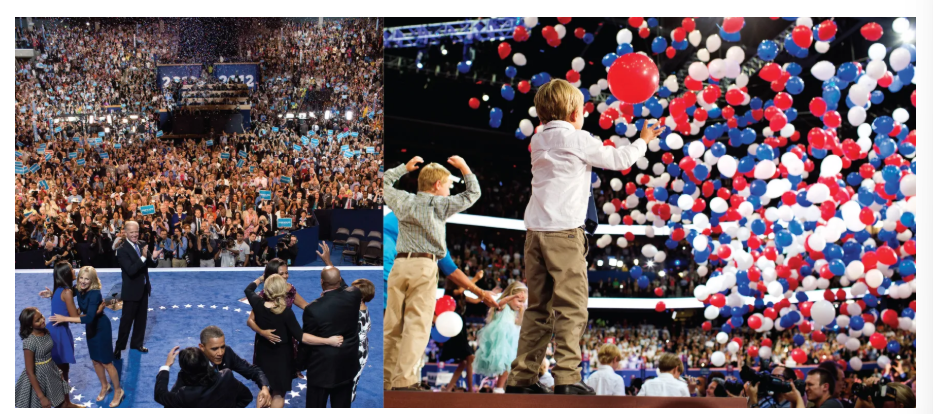
Figure 9.1.
The families of the 2012 presidential candidates joined in the festivities at the Democratic National Convention in Charlotte, North Carolina, (left) and the Republican National Convention in Tampa, Florida (right). In 2020, the COVID-19 pandemic prevented both the Democrats and the Republicans from staging traditional nominating conventions. In 2024, both parties again held traditional large conventions. (credit right: modification of work by “PBS NewsHour”/Flickr)
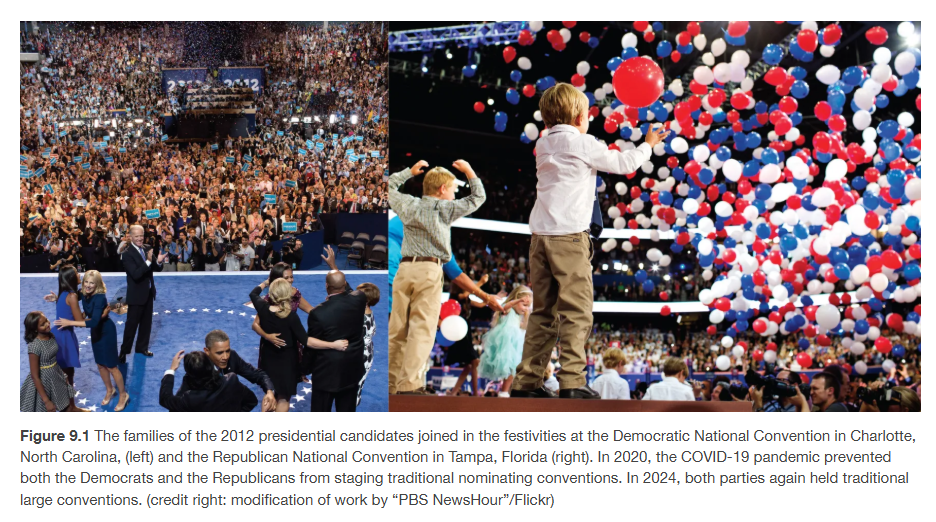
In 2012, Barack Obama accepted his second nomination to lead the Democratic Party into the presidential election (Figure 9.1). Explain.
During his first term, he had been attacked by pundits for his failure to convince congressional Republicans to work with him.
Despite that, he was wildly popular in his own party, and voters reelected him by a comfortable margin.
His second term seemed to go no better, however, with disagreements between the parties resulting in government shutdowns and the threat of credit defaults.
Yet just a few decades ago, then-president Dwight D. Eisenhower was criticized for failing to create a clear vision for his Republican Party, and Congress was lampooned for what was deemed a lack of real conflict over important issues.
Political parties, it seems, can never get it right—they are either too polarizing or too noncommittal.
At some point, most of us have found ourselves part of a group trying to solve a problem, like picking a restaurant or movie to attend, or completing a big project at school or work. Explain.
Members of the group probably had various opinions about what should be done.
Some may have even refused to help make the decision or to follow it once it had been made.
Still others may have been willing to follow along but were less interested in contributing to a workable solution.
Because of this disagreement, at some point, someone in the group had to find a way to make a decision, negotiate a compromise, and ultimately do the work needed for the group to accomplish its goals.
In Federalist No. 10, written in the late eighteenth century, James Madison noted that the formation of self-interested groups, which he called factions, was inevitable in any society, as individuals started to work together to protect themselves from the government. Interest groups and political parties are two of the most easily identified forms of factions in the United States. Explain.
These groups are similar in that they are both mediating institutions responsible for communicating public preferences to the government.
They are not themselves government institutions in a formal sense.
Neither is directly mentioned in the U.S. Constitution nor do they have any real, legal authority to influence policy.
But whereas interest groups often work indirectly to influence our leaders, political parties are organizations that try to directly influence public policy through its members who seek to win and hold public office.
Parties accomplish this by identifying and aligning sets of issues that are important to voters in the hopes of gaining support during elections; their positions on these critical issues are often presented in documents known as a party platform (Figure 9.2), which is adopted at each party’s presidential nominating convention every four years.
If successful, a party can create a large enough electoral coalition to gain control of the government.
Once in power, the party is then able to deliver, to its voters and elites, the policy preferences they choose by electing its partisans to the government.
In this respect, parties provide choices to the electorate, something they are doing that is in such sharp contrast to their opposition.
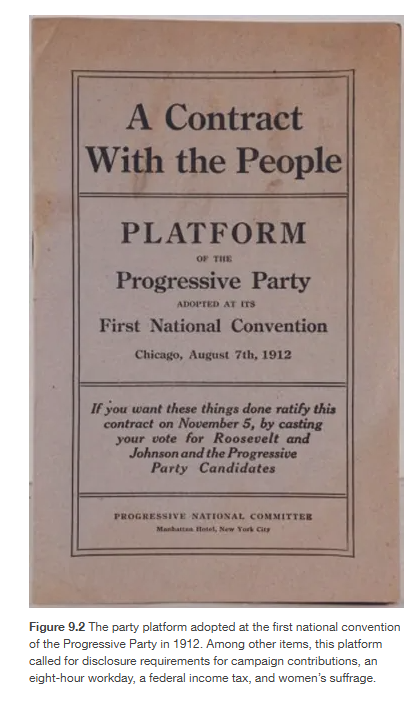
Winning elections and implementing policy would be hard enough in simple political systems, but in a country as complex as the United States, political parties must take on great responsibilities to win elections and coordinate behavior across the many local, state, and national governing bodies. Explain.
Indeed, political differences between states and local areas can contribute much complexity.
If a party stakes out issue positions on which few people agree and therefore builds too narrow a coalition of voter support, that party may find itself marginalized.
But if the party takes too broad a position on issues, it might find itself in a situation where the members of the party disagree with one another, making it difficult to pass legislation, even if the party can secure victory.
National political parties as we understand them today did not really exist in the United States during the early years of the republic. Explain.
Most politics during the time of the nation’s founding were local in nature and based on elite politics, limited suffrage (or the ability to vote in elections), and property ownership.
Residents of the various colonies, and later of the various states, were far more interested in events in their state legislatures than in those occurring at the national level or later in the nation’s capital.
To the extent that national issues did exist, they were largely limited to collective security efforts to deal with external rivals, such as the British or the French, and with perceived internal threats, such as conflicts with Native Americans.
Soon after the United States emerged from the Revolutionary War, however, a rift began to emerge between two groups that had very different views about the future direction of U.S. politics. Explain.
Thus, from the very beginning of its history, the United States has had a system of government dominated by two different philosophies.
Federalists, who were largely responsible for drafting and ratifying the U.S. Constitution, generally favored the idea of a stronger, more centralized republic that had greater control over regulating the economy.
Anti-Federalists preferred a more confederate system built on state equality and autonomy.
The Federalist faction, led by Alexander Hamilton, largely dominated the government in the years immediately after the Constitution was ratified.
Included in the Federalists was President George Washington, who was initially against the existence of parties in the United States.
When Washington decided to exit politics and leave office, he warned of the potential negative effects of parties in his farewell address to the nation, including their potentially divisive nature and the fact that they might not always focus on the common good but rather on partisan ends.
However, members of each faction quickly realized that they had a vested interest not only in nominating and electing a president who shared their views, but also in winning other elections.
Two loosely affiliated party coalitions, known as the Federalists and the Democratic-Republicans, soon emerged.
The Federalists succeeded in electing their first leader, John Adams, to the presidency in 1796, only to see the Democratic-Republicans gain victory under Thomas Jefferson four years later in 1800.
Milestone-The “Revolution of 1800”: Uniting the Executive Branch under One Party
When the U.S. Constitution was drafted, its authors were certainly aware that political parties existed in other countries (like Great Britain), but they hoped to avoid them in the United States.
They felt the importance of states in the U.S. federal structure would make it difficult for national parties to form.
They also hoped that having a college of electors vote for the executive branch, with the top two vote-getters becoming president and vice president, would discourage the formation of parties.
Their system worked for the first two presidential elections, when essentially all the electors voted for George Washington to serve as president.
But by 1796, the Federalist and Anti-Federalist camps had organized into electoral coalitions.
The Anti-Federalists joined with many others active in the process to become known as the Democratic-Republicans.
The Federalist John Adams won the Electoral College vote, but his authority was undermined when the vice presidency went to Democratic-Republican Thomas Jefferson, who finished second.
Four years later, the Democratic-Republicans managed to avoid this outcome by coordinating the electors to vote for their top two candidates.
But when the vote ended in a tie, it was ultimately left to Congress to decide who would be the third president of the United States (Figure 9.3).
In an effort to prevent a similar outcome in the future, Congress and the states voted to ratify the Twelfth Amendment, which went into effect in 1804.
This amendment changed the rules so that the president and vice president would be selected through separate elections within the Electoral College, and it altered the method that Congress used to fill the offices in the event that no candidate won a majority.
The amendment essentially endorsed the new party system and helped prevent future controversies.
It also served as an early effort by the two parties to collude to make it harder for an outsider to win the presidency.
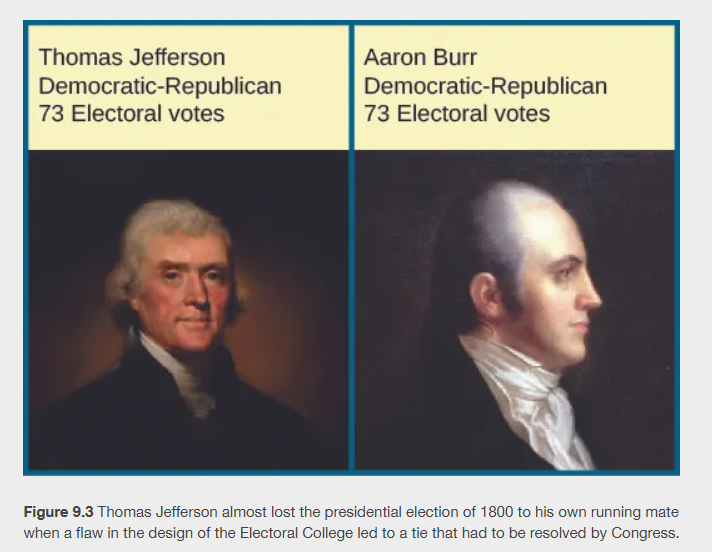
Growing regional tensions eroded the Federalist Party’s ability to coordinate elites, and it eventually collapsed following its opposition to the War of 1812. Explain.
The Democratic-Republican Party, on the other hand, eventually divided over whether national resources should be focused on economic and mercantile development, such as tariffs on imported goods and government funding of internal improvements like roads and canals, or on promoting populist issues that would help the “common man,” such as reducing or eliminating state property requirements that had prevented many men from voting.
In the election of 1824, numerous candidates contended for the presidency, all members of the Democratic-Republican Party. Andrew Jackson won more popular votes and more votes in the Electoral College than any other candidate. However, because he did not win the majority (more than half) of the available electoral votes, the election was decided by the House of Representatives, as required by the Twelfth Amendment. The Twelfth Amendment limited the House’s choice to the three candidates with the greatest number of electoral votes. Thus, Andrew Jackson, with 99 electoral votes, found himself in competition with only John Quincy Adams, the second place finisher with 84 electoral votes, and William H. Crawford, who had come in third with 41. The fourth-place finisher, Henry Clay, who was no longer in contention, had won 37 electoral votes. Clay strongly disliked Jackson, and his ideas on government support for tariffs and internal improvements were similar to those of Adams. Clay thus gave his support to Adams, who was chosen on the first ballot. Jackson considered the actions of Clay and Adams, the son of the Federalist president John Adams, to be an unjust triumph of supporters of the elite and referred to it as “the corrupt bargain.”
This marked the beginning of what historians call the Second Party System (the first parties had been the Federalists and the Jeffersonian Republicans), with the splitting of the Democratic-Republicans and the formation of two new political parties. Explain.
One half, called simply the Democratic Party, was the party of Jackson; it continued to advocate for the common people by championing westward expansion and opposing a national bank.
The branch of the Democratic-Republicans that believed that the national government should encourage economic (primarily industrial) development was briefly known as the National Republicans and later became the Whig Party.
In the election of 1828, Democrat Andrew Jackson was triumphant.
Three times as many people voted in 1828 as had in 1824, and most cast their ballots for him.
The Democratic Party emphasized personal politics, which focused on building direct relationships with voters rather than on promoting specific issues. Explain.
This party dominated national politics from Andrew Jackson’s presidential victory in 1828 until the mid-1850s, when regional tensions began to threaten the nation’s very existence.
The growing power of industrialists, who preferred greater national authority, combined with increasing tensions between the northern and southern states over slavery, led to the rise of the Republican Party and its leader Abraham Lincoln in the election of 1860, while the Democratic Party dominated in the South.
Like the Democrats, the Republicans also began to utilize a mass approach to party design and organization.
Their opposition to the expansion of slavery, and their role in helping to stabilize the Union during Reconstruction, made them the dominant player in national politics for the next several decades.
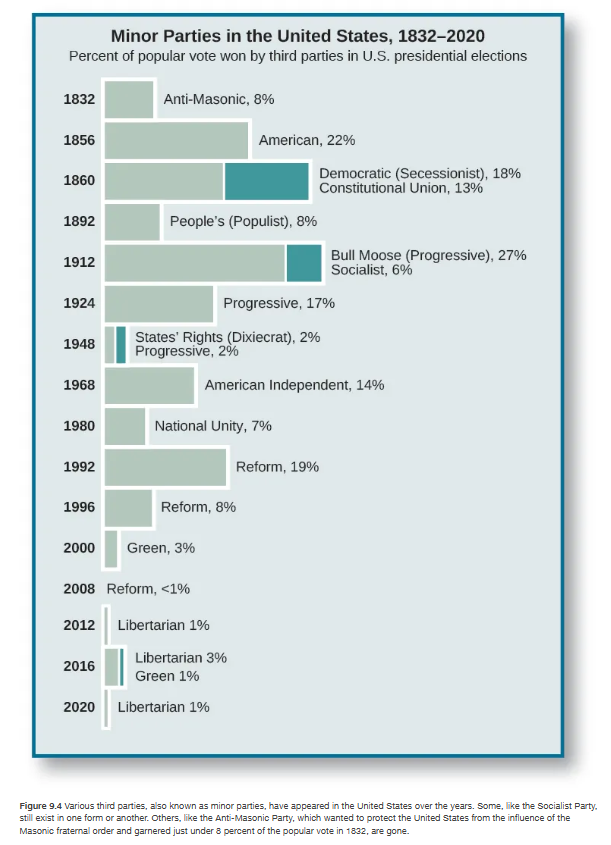
At various points in the past 170 years, elites and voters have sought to create alternatives to the existing party system. Political parties that are formed as alternatives to the Republican and Democratic parties are known as third parties, or minor parties (Figure 9.4). Explain.
In 1892, a third party known as the Populist Party formed in reaction to what its constituents perceived as the domination of U.S. society by big business and a decline in the power of farmers and rural communities.
The Populist Party called for the regulation of railroads, an income tax, and the popular election of U.S. senators, who at this time were chosen by state legislatures and not by ordinary voters.
The party’s candidate in the 1892 elections, James B. Weaver, did not perform as well as the two main party candidates, and, in the presidential election of 1896, the Populists supported the Democratic candidate William Jennings Bryan.
Bryan lost, and the Populists once again nominated their own presidential candidates in 1900, 1904, and 1908.
The party disappeared from the national scene after 1908, but its ideas were similar to those of the Progressive Party, a new political party created in 1912.
In 1912, former Republican president Theodore Roosevelt attempted to form a third party, known as the Progressive Party, as an alternative to the more business-minded Republicans. Explain.
The Progressives sought to correct the many problems that had arisen as the United States transformed itself from a rural, agricultural nation into an increasingly urbanized, industrialized country dominated by big business interests.
Among the reforms that the Progressive Party called for in its 1912 platform were women’s suffrage, an eight-hour workday, and workers’ compensation.
The party also favored some of the same reforms as the Populist Party, such as the direct election of U.S. senators and an income tax, although Populists tended to be farmers while the Progressives were from the middle class.
In general, Progressives sought to make government more responsive to the will of the people and to end political corruption in government.
They wished to break the power of party bosses and political machines, and called upon states to pass laws allowing voters to vote directly on proposed legislation, propose new laws, and recall from office incompetent or corrupt elected officials.
The Progressive Party largely disappeared after 1916, and most members returned to the Republican Party.
The party enjoyed a brief resurgence in 1924, when Robert “Fighting Bob” La Follette ran unsuccessfully for president under the Progressive banner.
None of these alternatives to the two major political parties had much success at the national level, and most are no longer viable parties. Explain.
All faced the same fate.
Formed by charismatic leaders, each championed a relatively narrow set of causes and failed to gain broad support among the electorate.
Once their leaders had been defeated or discredited, the party structures that were built to contest elections collapsed.
And within a few years, most of their supporters were eventually pulled back into one of the existing parties.
To be sure, some of these parties had an electoral impact.
For example, the Progressive Party pulled enough votes away from the Republicans to hand the 1912 election to the Democrats.
Thus, the third-party rival’s principal accomplishment was helping its least-preferred major party win, usually at the short-term expense of the very issue it championed.
In the long run, however, many third parties have brought important issues to the attention of the major parties, which then incorporated these issues into their platforms.
Understanding why this is the case is an important next step in learning about the issues and strategies of the modern Republican and Democratic parties.
In the next section, we look at why the United States has historically been dominated by only two political parties.
Why do we have two parties? Explain.
The two-party system came into being because the structure of U.S. elections, with one seat tied to a geographic district, tends to lead to dominance by two major political parties.
Even when there are other options on the ballot, most voters understand that minor parties have no real chance of winning even a single office.
Hence, they vote for candidates of the two major parties in order to support a potential winner.
Of the 535 members of the House and Senate, only a handful identify as something other than Republican or Democrat.
Third parties have fared no better in presidential elections.
No third-party candidate has ever won the presidency.
Some historians or political scientists might consider Abraham Lincoln to have been such a candidate, but in 1860, the Republicans were a major party that had subsumed members of earlier parties, such as the Whig Party, and they were the only major party other than the Democratic Party.
A number of reasons have been suggested to explain why the structure of U.S. elections has resulted in a two-party system. Explain.
Most of the blame has been placed on the process used to select its representatives.
First, most elections at the state and national levels are winner-take-all: The candidate who receives the greatest overall number of votes wins.
Winner-take-all elections with one representative elected for one geographic district allow voters to develop a personal relationship with “their” representative to the government.
They know exactly whom to blame, or thank, for the actions of that government.
But these elections also tend to limit the number of people who run for office.
Otherwise-qualified candidates might not stand for election if they feel the incumbent or another candidate has an early advantage in the race.
And since voters do not like to waste votes, third parties must convince voters they have a real chance of winning races before voters will take them seriously.
This is a tall order given the vast resources and mobilization tools available to the existing parties, especially if an incumbent is one of the competitors.
In turn, the likelihood that third-party challengers will lose an election bid makes it more difficult to raise funds to support later attempts.
In a system in which individual candidates compete for individual seats representing unique geographic districts, a candidate must receive a fairly large number of votes in order to win. Explain.
A political party that appeals to only a small percentage of voters will always lose to a party that is more popular.
Because second-place (or lower) finishers will receive no reward for their efforts, those parties that do not attract enough supporters to finish first at least some of the time will eventually disappear because their supporters realize they have no hope of achieving success at the polls.
The failure of third parties to win and the possibility that they will draw votes away from the party the voter had favored before—resulting in a win for the party the voter liked least—makes people hesitant to vote for the third party’s candidates a second time.
This has been the fate of all U.S. third parties—the Populist Party, the Progressives, the Dixiecrats, the Reform Party, and others.
Third parties, often born of frustration with the current system, attract supporters from one or both of the existing parties during an election but fail to attract enough votes to win. After the election is over, supporters experience remorse when their least-favorite candidate wins instead. Explain.
For example, in the 2000 election, Ralph Nader ran for president as the candidate of the Green Party.
Nader, a longtime consumer activist concerned with environmental issues and social justice, attracted many votes from people who usually voted for Democratic candidates.
This has caused some to claim that Democratic nominee Al Gore lost the 2000 election to Republican George W. Bush, because Nader won Democratic votes in Florida that might otherwise have gone to Gore (Figure 9.5).
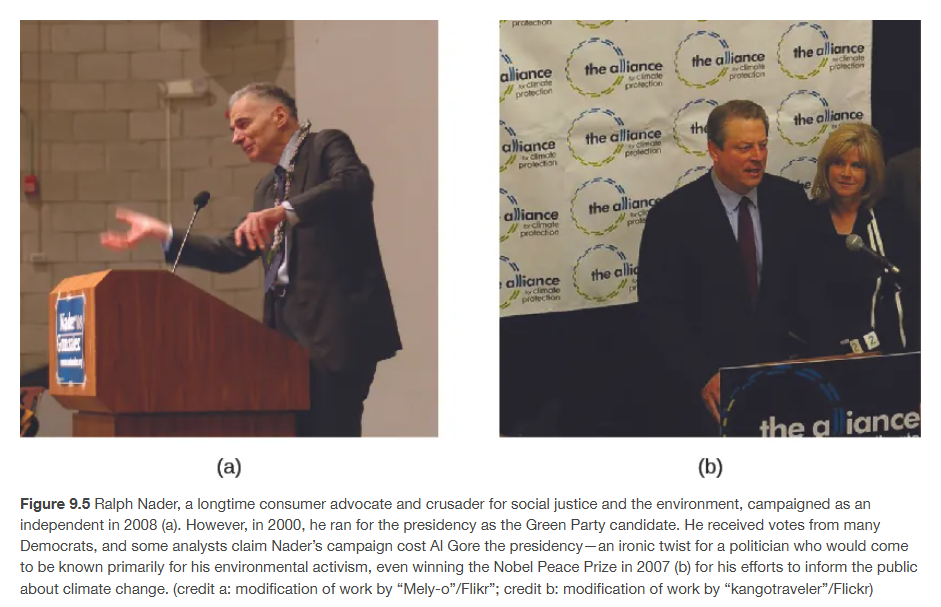
A second way to increase the number of parties in the U.S. system is to abandon the winner-take-all approach. Explain.
Rather than allowing voters to pick their representatives directly, many democracies have chosen to have voters pick their preferred party and allow the party to select the individuals who serve in government.
The argument for this method is that it is ultimately the party and not the individual who will influence policy.
Under this model of proportional representation, legislative seats are allocated to competing parties based on the total share of votes they receive in the election.
As a result, any given election can have multiple winners, and voters who might prefer a smaller party over a major one have a chance to be represented in government (Figure 9.6).
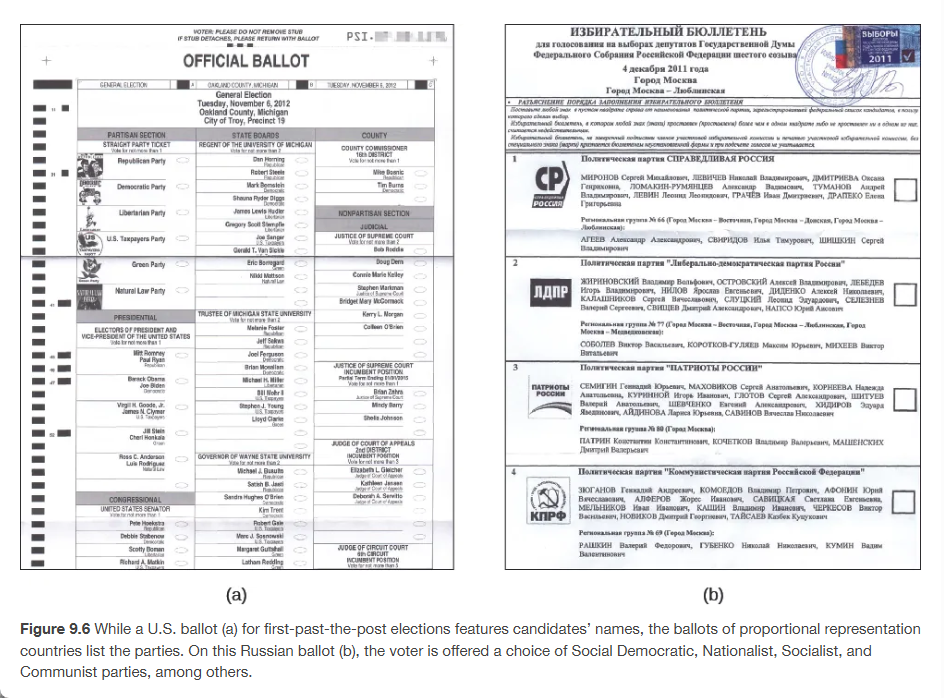
One possible way to implement proportional representation in the United States is to allocate legislative seats based on the national level of support for each party’s presidential candidate, rather than on the results of individual races. Explain.
If this method had been used in the 1996 elections, 8 percent of the seats in Congress would have gone to Ross Perot’s Reform Party because he won 8 percent of the votes cast.
Even though Perot himself lost, his supporters would have been rewarded for their efforts with representatives who had a real voice in government.
And Perot’s party’s chances of survival would have greatly increased.
Scholars of voting behavior have also suggested at least three other characteristics of the U.S. system that are likely to influence party outcomes: the Electoral College, demobilized ethnicity, and campaign and election laws. Explain.
First, the United States has a presidential system in which the winner is selected not directly by the popular vote but indirectly by a group of electors known collectively as the Electoral College.
The winner-take-all system also applies in the Electoral College. In all but two states (Maine and Nebraska), the total of the state’s electoral votes go to the candidate who wins the plurality of the popular vote in that state.
Even if a new, third party is able to win the support of a lot of voters, it must be able to do so in several states in order to win enough electoral votes to have a chance of winning the presidency.
Finally, party success is strongly influenced by local election laws. Explain.
Someone has to write the rules that govern elections, and those rules help to determine outcomes.
In the United States, such rules have been written to make it easy for existing parties to secure a spot for their candidates in future elections.
But some states create significant burdens for candidates who wish to run as independents or who choose to represent new parties.
For example, one common practice is to require a candidate who does not have the support of a major party to ask registered voters to sign a petition.
Sometimes, thousands of signatures are required before a candidate’s name can be placed on the ballot (Figure 9.7), but a small third party that does have large numbers of supporters in some states may not be able to secure enough signatures for this to happen.
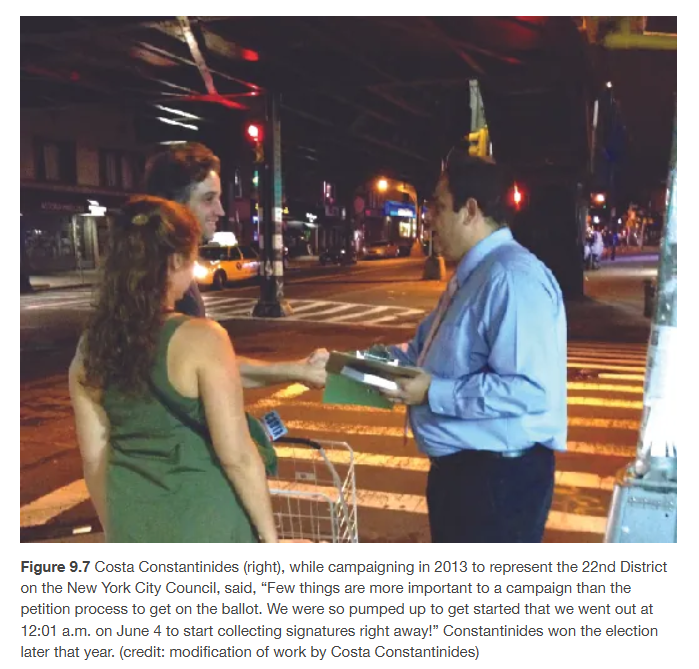
Political parties exist for the purpose of winning elections in order to influence public policy. Explain.
This requires them to build coalitions across a wide range of voters who share similar preferences.
Since most U.S. voters identify as moderates,24 the historical tendency has been for the two parties to compete for “the middle” while also trying to mobilize their more loyal bases.
If voters’ preferences remained stable for long periods of time, and if both parties did a good job of competing for their votes, we could expect Republicans and Democrats to be reasonably competitive in any given election.
Election outcomes would probably be based on the way voters compared the parties on the most important events of the day rather than on electoral strategy.
There are many reasons we would be wrong in these expectations, however. First, the electorate isn’t entirely stable. Each generation of voters has been a bit different from the last. Over time, the United States has become more socially liberal, especially on topics related to race and gender, and Millennials—those born between 1981 and 1996 are more liberal than members of older generations. The electorate’s economic preferences have changed, and different social groups are likely to become more engaged in politics now than they did in the past. Surveys conducted in 2016, for example, revealed that candidates’ religion is less important to voters than it once was. Also, as young Latinos reach voting age, they seem more inclined to vote than do their parents, which may raise the traditionally low voting rates among this ethnic group. Internal population shifts and displacements have also occurred, as various regions have taken their turn experiencing economic growth or stagnation, and as new waves of immigrants have come to U.S. shores.
Additionally, the major parties have not always been unified in their approach to contesting elections. Explain.
While we think of both Congress and the presidency as national offices, the reality is that congressional elections are sometimes more like local elections.
Voters may reflect on their preferences for national policy when deciding whom to send to the Senate or the House of Representatives, but they are very likely to view national policy in the context of its effects on their area, their family, or themselves, not based on what is happening to the country as a whole.
For example, while many voters want to reduce the federal budget, those over sixty-five are particularly concerned that no cuts to the Medicare program be made.
One-third of those polled reported that “senior’s issues” were most important to them when voting for national officeholders.
If they hope to keep their jobs, elected officials must thus be sensitive to preferences in their home constituencies as well as the preferences of their national party.
One of the best-known party realignments occurred when Democrats moved to include African Americans and other minorities into their national coalition during the Great Depression. Explain.
After the Civil War, Republicans, the party of Lincoln, were viewed as the party that had freed the enslaved.
Their efforts to provide Black people with greater legal rights earned them the support of African Americans in both the South, where they were newly enfranchised, and the Northeast.
When the Democrats, the party of the Confederacy, lost control of the South after the Civil War, Republicans ruled the region.
However, the Democrats regained control of the South after the removal of the Union army in 1877.
Democrats had largely supported slavery before the Civil War, and they opposed postwar efforts to integrate African Americans into society after they were liberated.
In addition, Democrats in the North and Midwest drew their greatest support from labor union members and immigrants who viewed African Americans as competitors for jobs and government resources, and who thus tended to oppose the extension of rights to African Americans as much as their southern counterparts did.
While the Democrats’ opposition to civil rights may have provided regional advantages in southern or urban elections, it was largely disastrous for national politics. From 1868 to 1931, Democratic candidates won just four of sixteen presidential elections. Two of these victories can be explained as a result of the spoiler effect of the Progressive Party in 1912 and then Woodrow Wilson’s reelection during World War I in 1916. This rather-dismal success rate suggested that a change in the governing coalition would be needed if the party were to have a chance at once again becoming a player on the national level.
That change began with the 1932 presidential campaign of Franklin Delano Roosevelt. Explain.
FDR determined that his best path toward victory was to create a new coalition based not on region or ethnicity, but on the suffering of those hurt the most during the Great Depression.
This alignment sought to bring African American voters in as a means of shoring up support in major urban areas and the Midwest, where many southern Black people had migrated in the decades after the Civil War in search of jobs and better education for their children, as well as to avoid many of the legal restrictions placed on them in the South.
Roosevelt accomplished this realignment by promising assistance to those hurt most by the Depression, including African Americans.
Almost fifty years after it had begun, the realignment of the two political parties resulted in the flipping of post-Civil War allegiances, with urban areas and the Northeast now solidly Democratic, and the South and rural areas overwhelmingly voting Republican. Explain.
The result today is a political system that provides Republicans with considerable advantages in rural areas and most parts of the Deep South.
Democrats dominate urban politics and those parts of the South, known as the Black Belt, where the majority of residents are African American.
A key fact about the U.S. political party system is that it’s all about the votes. Explain.
If voters do not show up to vote for a party’s candidates on Election Day, the party has no chance of gaining office and implementing its preferred policies.
As we have seen, for much of their history, the two parties have been adapting to changes in the size, composition, and preferences of the U.S. electorate.
It only makes sense, then, that parties have found it in their interest to build a permanent and stable presence among the voters.
By fostering a sense of loyalty, a party can insulate itself from changes in the system and improve its odds of winning elections.
The party-in-the-electorate are those members of the voting public who consider themselves to be part of a political party and/or who consistently prefer the candidates of one party over the other.
Party identifiers make up the majority of the voting public. Explain.
Gallup, the polling agency, has been collecting data on voter preferences for the past several decades.
Its research suggests that historically, over half of American adults have called themselves “Republican” or “Democrat” when asked how they identify themselves politically (Figure 9.8).
Even among self-proclaimed independents, the overwhelming majority claim to lean in the direction of one party or the other, suggesting they behave as if they identified with a party during elections even if they preferred not to publicly pick a side.
Partisan support is so strong that, in a poll conducted from August 5 to August 9, 2015, about 88 percent of respondents said they either identified with or, if they were independents, at least leaned toward one of the major political parties.
Thus, in a poll conducted in January 2016, even though about 42 percent of respondents said they were independent, this does not mean that they are not, in fact, more likely to favor one party over the other.
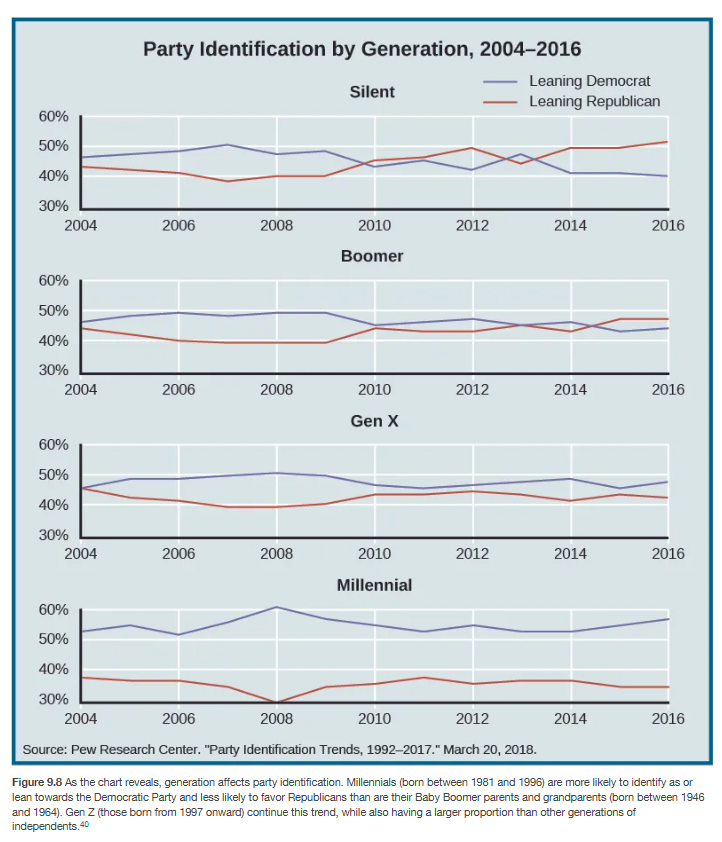
Strictly speaking, party identification is not quite the same thing as party membership. Explain.
People may call themselves Republicans or Democrats without being registered as a member of the party, and the Republican and Democratic parties do not require individuals to join their formal organization in the same way that parties in some other countries do.
Many states require voters to declare a party affiliation before participating in primaries, but primary participation is irregular and infrequent, and a voter may change identities long before changing party registration.
For most voters, party identification is informal at best and often matters only in the weeks before an election.
It does matter, however, because party identification guides some voters, who may know little about a particular issue or candidate, in casting their ballots.
If, for example, someone thinks of themself as a Republican and always votes Republican, they will not be confused when faced with a candidate, perhaps in a local or county election, whose name is unfamiliar.
If the candidate is a Republican, the voter will likely cast a ballot for that candidate.
Party ties can manifest in other ways as well. Explain.
The actual act of registering to vote and selecting a party reinforces party loyalty. Moreover, while pundits and scholars often deride voters who blindly vote their party, the selection of a party in the first place can be based on issue positions and ideology.
In that regard, voting your party on Election Day is not a blind act—it is a shortcut based on issue positions.
Since winning elections is the first goal of the political party, it makes sense that the formal party organization mirrors the local-state-federal structure of the U.S. political system. Explain.
While the lowest level of party organization is technically the precinct, many of the operational responsibilities for local elections fall upon the county-level organization.
The county-level organization is in many ways the workhorse of the party system, especially around election time.
This level of organization frequently takes on many of the most basic responsibilities of a democratic system, including identifying and mobilizing potential voters and donors, identifying and training potential candidates for public office, and recruiting new members for the party.
County organizations are also often responsible for finding rank and file members to serve as volunteers on Election Day, either as officials responsible for operating the polls or as monitors responsible for ensuring that elections are conducted honestly and fairly.
They may also hold regular meetings to provide members the opportunity to meet potential candidates and coordinate strategy (Figure 9.9).
Of course, all this is voluntary and relies on dedicated party members being willing to pitch in to run the party.
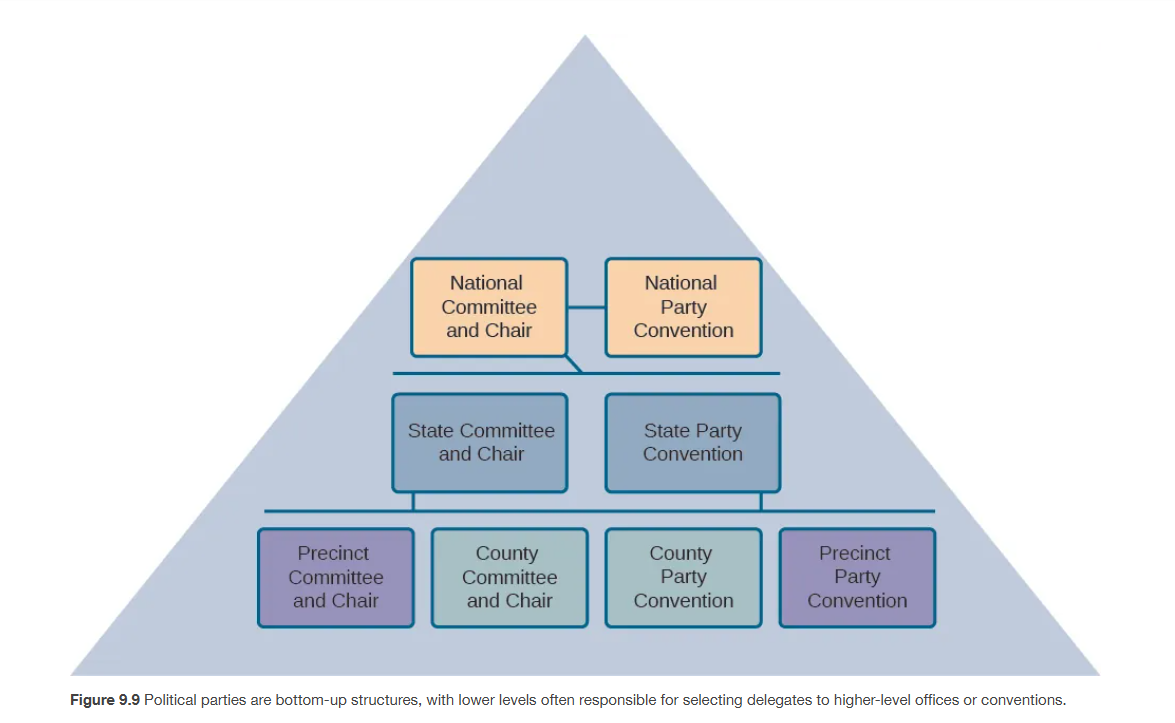
Most of the county organizations’ formal efforts are devoted to supporting party candidates running for county and city offices. Explain.
But a fair amount of political power is held by individuals in statewide office or in state-level legislative or judicial bodies.
While the county-level offices may be active in these local competitions, most of the coordination for them will take place in the state-level organizations.
Like their more local counterparts, state-level organizations are responsible for key party functions, such as statewide candidate recruitment and campaign mobilization.
Most of their efforts focus on electing high-ranking officials such as the governor or occupants of other statewide offices (e.g., the state’s treasurer or attorney general) as well as candidates to represent the state and its residents in the U.S. Senate and the U.S. House of Representatives.
The greater value of state- and national-level offices requires state organizations to take on several key responsibilities in the life of the party.
First, state-level organizations usually accept greater fundraising responsibilities than do their local counterparts. Statewide races and races for national office have become increasingly expensive in recent years. The average cost of a successful House campaign was $2.4 million in 2020; for Senate races, it was $27.2 million.
While individual candidates are responsible for funding and running their own races, it is typically up to the state-level organization to coordinate giving across multiple races and to develop the staffing expertise that these candidates will draw upon at election time.
State organizations are also responsible for creating a sense of unity among members of the state party. Explain.
Building unity can be very important as the party transitions from sometimes-contentious nomination battles to the all-important general election.
The state organization uses several key tools to get its members working together towards a common goal.
First, it helps the party’s candidates prepare for state primary elections or caucuses that allow voters to choose a nominee to run for public office at either the state or national level.
Caucuses are a form of town hall meeting at which voters in a precinct get together to voice their preferences, rather than voting individually throughout the day (Figure 9.10).
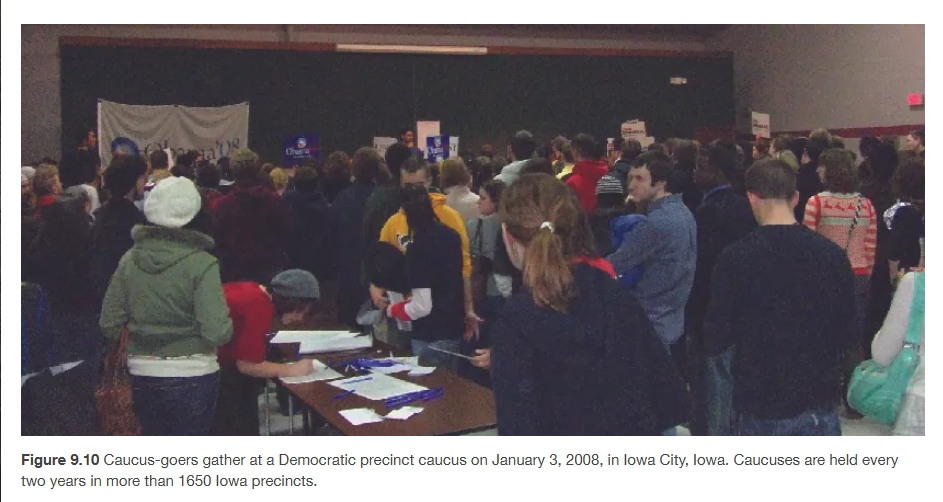
The local and state-level party organizations are the workhorses of the political process. Explain.
They take on most of the responsibility for party activities and are easily the most active participants in the party formation and electoral processes.
They are also largely invisible to most voters.
The average citizen knows very little of the local party’s behavior unless there is a phone call or a knock on the door in the days or weeks before an election.
The same is largely true of the activities of the state-level party.
Typically, the only people who notice are those who are already actively engaged in politics or are being targeted for donations.
But most people are aware of the presence and activity of the national party organizations for several reasons. First, many Americans, especially young people, are more interested in the topics discussed at the national level than at the state or local level. According to John Green of the Ray C. Bliss Institute of Applied Politics, “Local elections tend to be about things like sewers, and roads and police protection—which are not as dramatic an issue as same-sex marriage or global warming or international affairs.” Presidential elections and the behavior of the U.S. Congress are also far more likely to make the news broadcasts than the activities of county commissioners, and the national-level party organization is mostly responsible for coordinating the activities of participants at this level. The national party is a fundraising army for presidential candidates and also serves a key role in trying to coordinate and direct the efforts of the House and Senate. For this reason, its leadership is far more likely to become visible to media consumers, whether they intend to vote or not.
A second reason for the prominence of the national organization is that it usually coordinates the grandest spectacles in the life of a political party. Explain.
Most voters are never aware of the numerous county-level meetings or coordinating activities.
Primary elections, one of the most important events to take place at the state level, have a much lower turnout than the nationwide general election.
In 2012, for example, only one-third of the eligible voters in New Hampshire voted in the state’s primary, one of the earliest and thus most important in the nation; however, 70 percent of eligible voters in the state voted in the general election in November 2012.
People may see or read an occasional story about the meetings of the state committees or convention but pay little attention.
But the national conventions, organized and sponsored by the national-level party, can dominate the national discussion for several weeks in late summer, a time when the major media outlets are often searching for news.
These conventions are the definition of a media circus at which high-ranking politicians, party elites, and sometimes celebrities, such as actor/director Clint Eastwood (Figure 9.11), along with individuals many consider to be the future leaders of the party are brought before the public so the party can make its best case for being the one to direct the future of the country.
National party conventions culminate in the formal nomination of the party nominees for the offices of president and vice president, and they mark the official beginning of the presidential competition between the two parties.
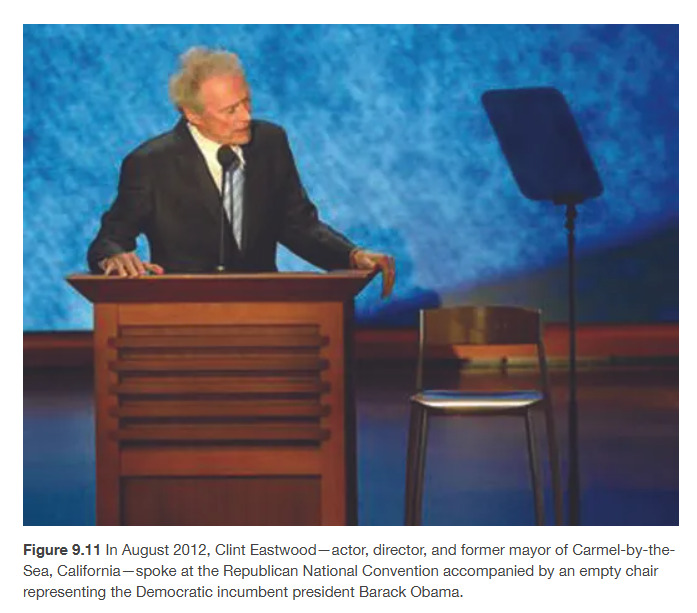
In the past, national conventions were often the sites of high drama and political intrigue. Explain.
As late as 1968, the identities of the presidential and/or vice-presidential nominees were still unknown to the general public when the convention opened.
It was also common for groups protesting key events and issues of the day to try to raise their profile by using the conventions to gain the media spotlight.
National media outlets would provide “gavel to gavel” coverage of the conventions, and the relatively limited number of national broadcast channels meant most viewers were essentially forced to choose between following the conventions or checking out of the media altogether.
Much has changed since the 1960s, however, and between 1960 and 2004, viewership of both the Democratic National Convention and the Republican National Convention had declined by half.
With the advent of cable TV news and the growth of internet blogging, the major news outlets have found it unnecessary to provide the same level of coverage they once did. Explain.
Between 1976 and 1996, ABC and CBS cut their coverage of the nominating conventions from more than fifty hours to only five.
NBC cut its coverage to fewer than five hours.
One reason may be that the outcome of nominating conventions are also typically known in advance, meaning there is no drama.
Today, the nominee’s acceptance speech is expected to be no longer than an hour, so it will not take up more than one block of prime-time TV programming.
Insider Perspective-Conventions and Trial Balloons
While both political parties use conventions to help win the current elections, they also use them as a way of elevating local politicians to the national spotlight.
This has been particularly true for the Democratic Party.
In 1988, the Democrats tapped Arkansas governor Bill Clinton to introduce their nominee Michael Dukakis at the convention.
Clinton’s speech was lampooned for its length and lack of focus, but it served to get his name in front of Democratic voters.
Four years later, Clinton was able to leverage this national exposure to help his own presidential campaign.
The pattern was repeated when Illinois state senator Barack Obama gave the keynote address at the 2004 convention.
Although he was only a candidate for the U.S. Senate at the time, his address caught the attention of the Democratic establishment and ultimately led to his emergence as a viable presidential candidate just four years later.
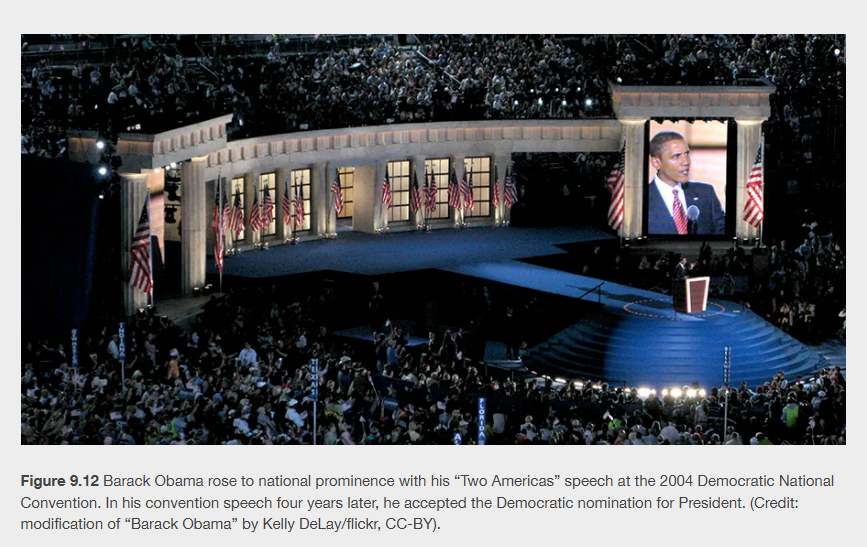
One of the first challenges facing the party-in-government, or the party identifiers who have been elected or appointed to hold public office, is to achieve their policy goals. Explain.
The means to do this is chosen in meetings of the two major parties; Republican meetings are called party conferences and Democrat meetings are called party caucuses.
Members of each party meet in these closed sessions and discuss what items to place on the legislative agenda and make decisions about which party members should serve on the committees that draft proposed laws.
Party members also elect the leaders of their respective parties in the House and the Senate, and their party whips.
Leaders serve as party managers and are the highest-ranking members of the party in each chamber of Congress.
The party whip ensures that members are present when a piece of legislation is to be voted on and directs them how to vote.
The whip is the second-highest ranking member of the party in each chamber.
Thus, both the Republicans and the Democrats have a leader and a whip in the House, and a leader and a whip in the Senate.
The leader and whip of the party that holds the majority of seats in each house are known as the majority leader and the majority whip.
The leader and whip of the party with fewer seats are called the minority leader and the minority whip.
The party that controls the majority of seats in the House of Representatives also elects someone to serve as Speaker of the House.
People elected to Congress as independents (that is, not members of either the Republican or Democratic parties) must choose a party to conference or caucus with.
For example, Senator Bernie Sanders of Vermont, who originally ran for Senate as an independent candidate, caucuses with the Democrats and ran for the presidency as a Democrat.
He returned to the Senate in 2017 as an independent.
One problem facing the party-in-government relates to the design of the country’s political system. Explain.
The U.S. government is based on a complex principle of separation of powers, with power divided among the executive, legislative, and judiciary branches.
The system is further complicated by federalism, which relegates some powers to the states, which also have separation of powers.
This complexity creates a number of problems for maintaining party unity.
The biggest is that each level and unit of government has different constituencies that the office holder must satisfy.
The person elected to the White House is more beholden to the national party organization than are members of the House or Senate, because members of Congress must be reelected by voters in very different states, each with its own state-level and county-level parties.
Members of the legislature from the executive’s party are under a great deal of pressure to make the executive look good, because a popular president or governor may be able to help other party members win office, or may support the primary opponent of an incumbent office holder. Explain.
This incentive is likely why early in President Donald Trump’s second term of office, in 2025, that House and Senate Republicans chose not to challenge or protest the president’s aggressive moves, which started by challenging the judiciary, but eventually moved into areas of traditionally congressional power, including taxation, removing officials from independent regulatory commissions, and making personnel moves in institutions such as the Library of Congress.
In 1950, the American Political Science Association’s Committee on Political Parties (APSA) published an article offering a criticism of the current party system. Explain.
The parties, it argued, were too similar.
Distinct, cohesive political parties were critical for any well-functioning democracy.
First, distinct parties offer voters clear policy choices at election time.
Second, cohesive parties could deliver on their agenda, even under conditions of lower bipartisanship.
The party that lost the election was also important to democracy because it served as the “loyal opposition” that could keep a check on the excesses of the party in power.
Finally, the paper suggested that voters could signal whether they preferred the vision of the current leadership or of the opposition.
This signaling would keep both parties accountable to the people and lead to a more effective government, better capable of meeting the country’s needs.
The problem of majority versus minority politics is particularly acute under conditions of divided government. Explain.
Divided government occurs when one or more houses of the legislature are controlled by the party in opposition to the executive.
Unified government occurs when the same party controls the executive and the legislature entirely.
Divided government can pose considerable difficulties for both the operations of the party and the government as a whole.
It makes fulfilling campaign promises extremely difficult, for instance, since the cooperation (or at least the agreement) of both Congress and the president is typically needed to pass legislation.
Furthermore, one party can hardly claim credit for success when the other side has been a credible partner, or when nothing can be accomplished.
Party loyalty may be challenged too, because individual politicians might be forced to oppose their own party agenda if it will help their personal reelection bids.
Clearly, the parties’ willingness to work together and compromise can be a very good thing. Explain.
However, the past several decades have brought an increased prevalence of divided government.
Since 1969, the U.S. electorate has sent the president a Congress of his own party in only seven of twenty-three congressional elections, and during George W. Bush’s first administration, the Republican majority was so narrow that a combination of resignations and defections gave the Democrats control before the next election could be held.
For the first few decades of the current pattern of divided government, the threat it posed to the government appears to have been muted by a high degree of bipartisanship, or cooperation through compromise. Explain.
Many pieces of legislation were passed in the 1960s and 1970s with reasonably high levels of support from both parties.
Most members of Congress had relatively moderate voting records, with regional differences within parties that made bipartisanship on many issues more likely.
The past thirty years have brought a dramatic change in the relationship between the two parties as fewer conservative Democrats and liberal Republicans have been elected to office. Explain.
As political moderates, or individuals with ideologies in the middle of the ideological spectrum, leave the political parties at all levels, the parties have grown farther apart ideologically, a result called party polarization.
In other words, at least organizationally and in government, Republicans and Democrats have become increasingly dissimilar from one another (Figure 9.14).
In the party-in-government, this means fewer members of Congress have mixed voting records; instead they vote far more consistently on issues and are far more likely to side with their party leadership.
It also means a growing number of moderate voters aren’t participating in party politics.
Either they are becoming independents, or they are participating only in the general election and are therefore not helping select party candidates in primaries.

Recently, however, a new voice emerged that allied itself with the Republican Party. Explain.
Born in part from an older third-party movement known as the Libertarian Party, the Tea Party was more hostile to government and viewed government intervention in all forms, especially taxation and the regulation of business, as a threat to capitalism and democracy.
It was less willing to tolerate interventions in the market place, even when they were designed to protect the markets themselves.
Although an anti-tax faction within the Republican Party has existed for some time, some factions of the Tea Party movement were also active at the intersection of religious liberty and social issues, especially in opposing such initiatives as same-sex marriage and abortion rights.
The Tea Party argued that government, both directly and by neglect, was threatening the ability of evangelicals to observe their moral obligations, including practices some perceive as endorsing social exclusion.
Movements on the left have also arisen. Explain.
The Occupy Wall Street movement was born of the government’s response to the Great Recession of 2008 and its assistance to endangered financial institutions, provided through the Troubled Asset Relief Program, TARP (Figure 9.16).
The Occupy Movement believed the recession was caused by a failure of the government to properly regulate the banking industry.
The Occupiers further maintained that the government moved swiftly to protect the banking industry from the worst of the recession but largely failed to protect the average person, thereby worsening the growing economic inequality in the United States.
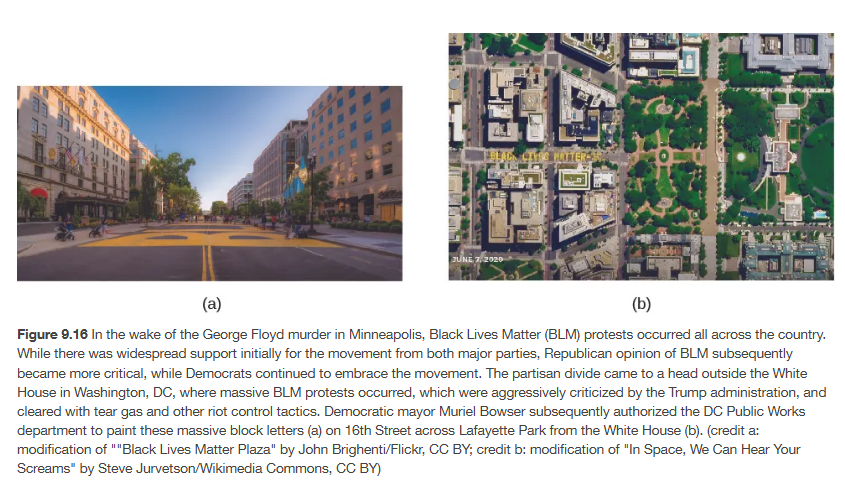
While the Occupy Movement itself has largely fizzled, the anti-business sentiment to which it gave voice continues within the Democratic Party, and many Democrats have proclaimed their support for the movement and its ideals, if not for its tactics. Explain.
Champions of the left wing of the Democratic Party, however, such as former presidential candidate Senator Bernie Sanders and Massachusetts senator Elizabeth Warren, have ensured that the Occupy Movement’s calls for more social spending and higher taxes on the wealthy remain a prominent part of the national debate.
Their popularity, and the growing visibility of race issues in the United States, have helped sustain the left wing of the Democratic Party.
Bernie Sanders’ 2016 presidential run made these topics and causes even more salient, especially among younger voters.
Several incidents since that time, most notably the murder of George Floyd on May 25, 2020, have caused the Black Lives Matter movement, which began in 2013 after the acquittal of George Zimmerman in the shooting death of Trayvon Martin in April 2012, to expand.
Black Lives Matter protests took place in record numbers in 2020.
Unfortunately, party factions haven’t been the only result of party polarization. Explain.
By most measures, the U.S. government in general and Congress in particular have become less effective in recent years.
Congress has passed fewer pieces of legislation, confirmed fewer appointees, and been less effective at handling the national purse than in recent memory.
If we define effectiveness as legislative productivity, the 106th Congress (1999–2000) passed 463 pieces of substantive legislation (not including commemorative legislation, such as bills proclaiming an official doughnut of the United States).
The 107th Congress (2000–2001) passed 294 such pieces of legislation. By 2013–2014, the total had fallen to 212.
Scholars agree that some degree of polarization is occurring in the United States, even if some contend it is only at the elite level. Explain.
But they are less certain about exactly why, or how, polarization has become such a mainstay of American politics.
Several conflicting theories have been offered.
The first and perhaps best argument is that polarization is a party-in-government phenomenon driven by a decades-long sorting of the voting public, or a change in party allegiance in response to shifts in party position.
According to the sorting thesis, before the 1950s, voters were mostly concerned with state-level party positions rather than national party concerns.
Since parties are bottom-up institutions, this meant local issues dominated elections; it also meant national-level politicians typically paid more attention to local problems than to national party politics.
The Democratic alliance worked relatively well through the 1930s and 1940s when post-Depression politics revolved around supporting farmers and helping the unemployed. But in the late 1950s and early 1960s, social issues became increasingly prominent in national politics. Explain.
Southern Democrats, who had supported giving the federal government authority for economic redistribution, began to resist calls for those powers to be used to restructure society.
Many of these Democrats broke away from the party only to find a home among Republicans, who were willing to help promote smaller national government and greater states’ rights.
This shift was largely completed with the rise of the evangelical movement in politics, when it shepherded its supporters away from Jimmy Carter, an evangelical Christian, to Ronald Reagan in the 1980 presidential election.
A second possible culprit in increased polarization is the impact of technology on the public square. Explain.
Before the 1950s, most people got their news from regional newspapers and local radio stations.
While some national programming did exist, most editorial control was in the hands of local publishers and editorial boards.
These groups served as a filter of sorts as they tried to meet the demands of local markets.
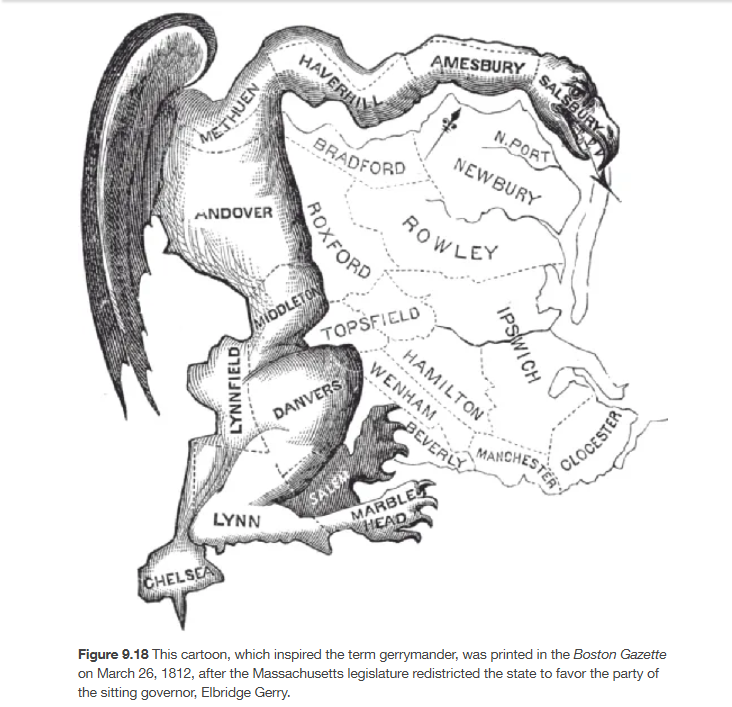
A final possible cause for polarization is the increasing sophistication of gerrymandering, or the manipulation of legislative districts in an attempt to favor a particular candidate (Figure 9.18). Explain.
According to the gerrymandering thesis, the more moderate or heterogeneous a voting district, the more moderate the politician’s behavior once in office.
Taking extreme or one-sided positions on a large number of issues would be hazardous for a member who needs to build a diverse electoral coalition.
But if the district has been drawn to favor a particular group, it now is necessary for the elected official to serve only the portion of the constituency that dominates.
Gerrymandering is a centuries-old practice. Explain.
There has always been an incentive for legislative bodies to draw districts in such a way that sitting legislators have the best chance of keeping their jobs.
But changes in law and technology have transformed gerrymandering from a crude art into a science.
The first advance came with the introduction of the “one-person-one-vote” principle by the U.S. Supreme Court in 1962.
Before then, it was common for many states to practice redistricting, or redrawing of their electoral maps, only if they gained or lost seats in the U.S. House of Representatives.
This can happen once every ten years as a result of a constitutionally mandated reapportionment process, in which the number of House seats given to each state is adjusted to account for population changes.
Of course, many early efforts at post-Reynolds gerrymandering were crude since map designers had no good way of knowing exactly where partisans lived. Explain.
At best, designers might have a rough idea of voting patterns between precincts, but they lacked the ability to know voting patterns in individual blocks or neighborhoods.
They also had to contend with the inherent mobility of the U.S. population, which meant the most carefully drawn maps could be obsolete just a few years later.
Designers were often forced to use crude proxies for party, such as race or the socio-economic status of a neighborhood (Figure 9.19).
Some maps were so crude they were ruled unconstitutionally discriminatory by the courts.
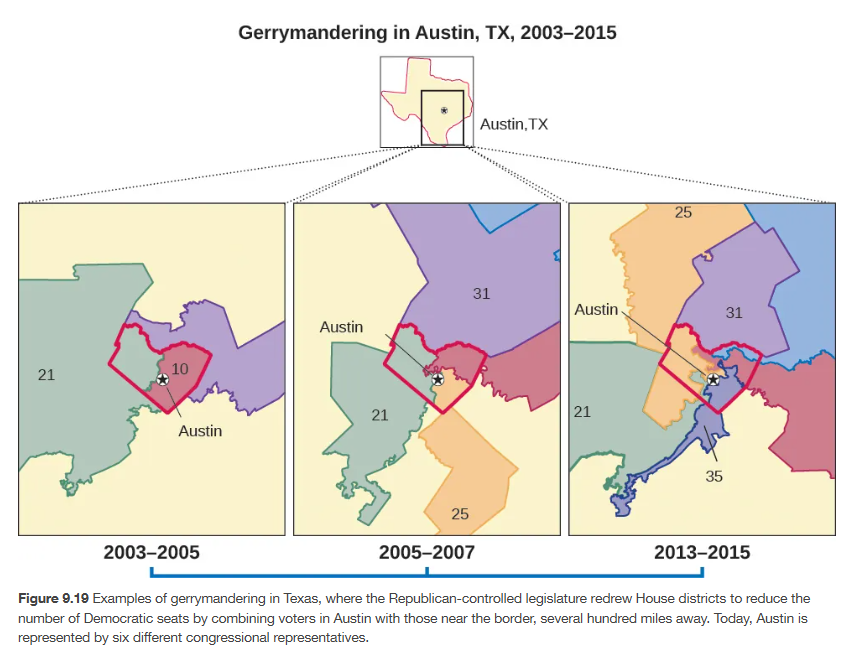
Proponents of the gerrymandering thesis point out that the decline in the number of moderate voters began during this period of increased redistricting. But it wasn’t until later, they argue, that the real effects could be seen. Explain.
A second advance in redistricting, via computer-aided map making, truly transformed gerrymandering into a science.
Refined computing technology, the ability to collect data about potential voters, and the use of advanced algorithms have given map makers a good deal of certainty about where to place district boundaries to best predetermine the outcomes.
These factors also provided better predictions about future population shifts, making the effects of gerrymandering more stable over time.
Proponents argue that this increased efficiency in map drawing has led to the disappearance of moderates in Congress.
Furthermore, polarization has been occurring throughout the country, but the use of increasingly polarized district design has not. Explain.
While some states have seen an increase in these practices, many states were already largely dominated by a single party (such as in the Solid South) but still elected moderate representatives.
Some parts of the country have remained closely divided between the two parties, making overt attempts at gerrymandering difficult.
But when coupled with the sorting phenomenon discussed above, redistricting probably is contributing to polarization, if only at the margins.
Finding a Middle Ground-The Politics of Redistricting
Voters in a number of states have become so worried about the problem of gerrymandering that they have tried to deny their legislatures the ability to draw district boundaries.
The hope is that by taking this power away from whichever party controls the state legislature, voters can ensure more competitive districts and fairer electoral outcomes.
In 2000, voters in Arizona approved a referendum that created an independent state commission responsible for drafting legislative districts.
But the Arizona legislature fought back against the creation of the commission, filing a lawsuit that claimed only the legislature had the constitutional right to draw districts.
Legislators asked the courts to overturn the popular referendum and end the operation of the redistricting commission.
However, the U.S. Supreme Court upheld the authority of the independent commission in a 5–4 decision titled Arizona State Legislature v. Arizona Independent Redistricting Commission (2015).
Currently, only five states use fully independent commissions—ones that do not include legislators or other elected officials—to draw the lines for both state legislative and congressional districts.
These states are Arizona, California, Idaho, Montana, and Washington. \
In Florida, the League of Women Voters and Common Cause challenged a new voting districts map supported by state Republicans, because they did not believe it fulfilled the requirements of amendments made to the state constitution in 2010 requiring that voting districts not favor any political party or incumbent.